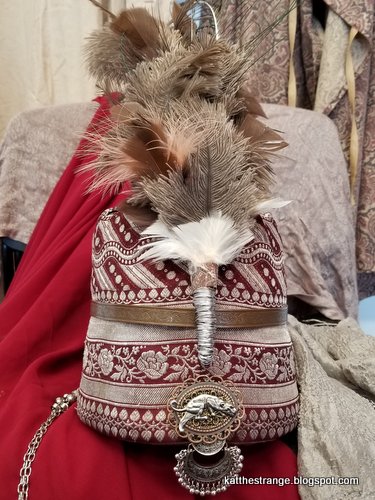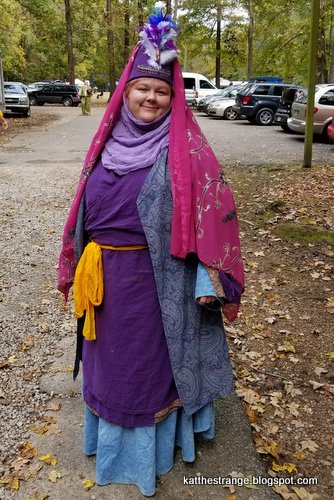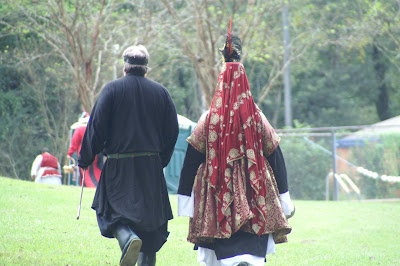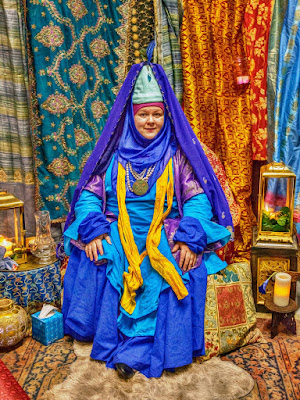For weeks, my partner Grav Weldon (known in the Society as Jali Bukha) and I have been working to assemble a complete Mughal outfit based on the different pieces I've documented through the examination of the existing illuminations of the time.
The image on the left is the one I've been attempting to completely reconstruct. The right is the finished product... almost. The final piece is the sash/belt, seen in white. I'm replicating mine in yellow gold. It's finished but not photographed.
Here are the pieces that influenced my choices:
Hat shape, fall of outer veil, long sleeves under shorter sleeves, floor length dress. This piece painted in the last 20 years of the 16th century depicts a scene from 1507. It appears in the Baburnama, a collection of illuminations on the life of the first Mughal emperor, Babur. Reference link.
Shape of hat, patterned fabric, plume, underveils. This illumination by the artist Bishinadas is reportedly of the birth of Jahangir, the fourth Mughal emperor who ruled in the 17th century. This piece represents those in attendence at the birth in August 1580. Reference link.
From the same source, variations in hats, hat shape, how the hat lays on the head, underveil.
Same piece, shape of hat, underveil, placement of hat.
Makeup, hat patterning, same piece (read more about what I found in this piece here).
Hat, veil, underdress and overdress are seen here in this sketch depicting Shirin entertaining Khusraw in a garden pavilion was reportedly commissioned by Akbar in 1595. This woman appears at the bottom right corner. Reference link.
Coat over deel or dress, hat, bandolier-style jewelry across chest, veils - the lady in green and yellow is Khanzada Begun, older sister of Babur. On the far left, a woman wears a coat over a deel, a hat with veil and a scarf. Reference link.
Amidst dancers in short sleeve, short hemmed dresses with pants, a Mughal woman looks on the scene The captured dancers behind her are being presented for Emperor Akbar, the third of the Mughal line. She may be Mariam Uz-Zumani in an early illumination representation. Later representations of the first wife of Akbar show her in far more modern dress, usually in a different hat or decked in Hindi wear such as choli, veil and skirts. Note the overlength sleeves for the underdress, seen whole this time. Reference link.
While the majority of the illumination this detail is taken from concerns an attack on the life of Akbar in 1564, there is no determination of what's going on in its upper left quadrant. The seated lady, once again believed to be Mariam Um-Zamani, show a shorter hat and another overlength sleeve dress - but on the seated figure's left side, the sleeve is pulled back. Reference link.
Bandolier-style jewelry "chestlaces," layered clothing with sleeves of differing length, plumes, hat shape, scarf. Dancers celebrating the marriage of Akbar's foster mother, Maham Anaga from the Akbarnama. Reference link.
Hat shape, underveil, overveil, pants (see leggings) and proof a Mughal woman can sit in a chair. From Bishandas' Birth of a Prince. Reference link.
Hat, veils, coat, caftan, scarf/belt, plume. This dancing woman and her friend all have it going on. The image is actually from Birth of a Royal Infant. Here's my take on the entire piece, which includes women from all walks of life in the harem. Reference link.
The inspiration for making the hat came from an illustration in the Chingiznama, the book of illuminations commissioned by Akbar to document the life of his ancestor Genghis Khan. The image in question is held by the Smithsonian as part of its Mughal period art collection and is found here. Amongst the women in the image, you'll see hat-wearers and one woman whose hat is, literally, a basket.
It all brings me back to the original image.
It is a piece in the Read Mughal Album, held by the Morgan Library and Museum in New York, entitled Babur Seeks Advice From His Grandmother (link to full illumination here). The singular image of Babur, the first Mughal emperor, consulting with Aisan Daulet Begun, a granddaughter of Genghis Khan and a right advisor in Baburian times, inspired me to seek out Mughal costume, culture and more.
So, let's begin.
That's me and all the pieces I will wear in this demonstration.
Each layer has its purpose. The idea of wearing all the fabric isn't just a sign of excess. Higher elevations in some areas conquered by the Mughals resulted in some pretty cold temperatures from time to time. You'll notice in the details of illuminations above those long completely body covering layers.
First, the undershift. While later references talk about a bra band, those bands were in direct relation to choli-and-petticoat fashion. Also here, pants obtained mundanely. The shift was pennies at the Goodwill by-the-pound, and the pants were $2 at Walmart.
Caftan or underdress, based on the Baburian example and such. The sleeves protrude four to six inches beyond the cut of my knuckles. While determining much about the sleeve other than the length is difficult, I've gone with the Persian adaptation of slit sleeves. After all, unlike Mughal princesses, I don't have a personal attendant to dress me. The caftan was constructed from a cotton duvet cover obtained from the local Goodwill-by-the-pound. It took me a couple of hours to construct.
I am planning to add a front slit of about four inches - this chokes me a bit, and I see plenty of the slits in the illuminations.
The deel, another layer which brings forward the idea of the Mongolian deel. Unlike those, this one has the long slit sleeves of later styles. It was constructed from a single king sized sheet obtained at the local Goodwill-by-the-pound by Jali Bukha, adapted from a pattern he has developed in constructing Mughal and Mongol deels.
The lined coat took the most time to construct. Between the layout, cutting, sewing and lining, it took Jali about 50 hours to carefully piece this out and put it together. It's constructed from a saree I purchased about a decade ago at an Indian store in Vermont.The original saree had a few tears (I got two for $35) but he was able to work around that. The photo does not do this piece justice.
The boqta hat is a design I've been refining over the past two years. I've compared what I've been doing to the original illustrations and cross-referencing the idea with extant examples in other time periods and cultures, refining by how it actually fits on the head. Since most of the illuminations show hair below the hat, without a turban, this is the first of the hats I created with an extra layer. The base is a woven basket (flower pot) with the plastic interior removed, covered with a layer of felt sewn on tightly and over the bottom edge into the hat, then a remnant of the saree carefully placed, tacked and blind stitched. The feathers are a plume I constricted with a base of two peacock feathers, fluffed out with feathers from an old blown out ostrich feather furniture duster, enhanced with a few white and pink craft feathers, tied together with embroidery floss and glued together with Elmer's School Glue, wound with nickel wire onto a large safety pin. The tikka is actually a Turkish earring, and the GOA band and copper and nickle panther pin were objects I already owned.
I did my best to match the pattern. Under the top of the hat, there's an additional double layer of felt, which should help with pinning veils onto the hat.
This is the underveil attached to the hat. To fit it, I place the very center of the veil under my chin and pull the veil tight before pinning it.
The gray scarf was discovered and picked up at Goodwill-by-the-pound ,while the bilous overveil came from my old collection, a dupatta or dance veil previously from my daughter's stock.
While it's hard to see on the full shots, there are four silver chains as part of the get-up. I've included some pendants that are either from an award I have received or a badge there-of.
Now let's put it all together.
To start, I changed out my makeup. Mughal women tended to have lips and teeth of red, thanks to the popularity of chewing the betel leaf. I'm not that dedicated, so this is just lipstick close to the color. I also tried a press-on jewel for a bindi - but removed it after this attempt. The tikka on the hat makes a bindi superfluous, and considering how easy it would be to add a dot to any illumination, I'm not certain the bindi is period for the Mughals.
Underlayer on. During summer months I won't wear the shift. I live in Arkansas. It's hot here. The shift is the layer that would traditionally be washed so the rest of the outfit did not need it. However, since I have gone with a plain underdress that can easily be washed, I'm not so concerned about it. For this demonstration, though, it's necessary.
Most people will never see the pants, but I do plan to learn how to make more appropriate pants in the future. The pumpkin pants and baggier pantaloons of my Elizabethan-wearing days just won't work here.
The undercaftan with its long over-the-finger sleeves. In period this would have been made from several sections of fabric but here I've simplified it and cut the entire thing out of a duvet cover. Future effort will include a center seam and separate fully lined sleeves.
As you can see here, I've created this undercaftan with slit sleeves. I'm not certain that's what I saw in the 1564 image above, but I do see a hand outside the sleeves, and with those lengths I suspect a slit had to be in place.
Over this goes the del or jama layer. This version is augmented from Jali's Mongolian del pattern (which you can find here) with the addition of slit sleeves lined to the elbows. From the illuminations, it appears it would be just fine to wear this garment open by itself over the undercaftan, but we're going for full-on court garb here.
When the del is tied (two tie closures along each side) it gives this nice shape to the ensemble. Because of the pattern, it's difficult to see the criss-cross at the top, but it's there.
The short sleeved coat cut from the antique saree and a gifted piece of black silk for the lining, over the del and caftan. This is heavier than it looks, thanks to the silver in the cloth. At this point, I have four layers of fabric on my backside and five on the front (due to the overlap of the del). It was 84 degrees outside. The heat was already starting to build up.
Up to this point, everything is on the body. Now it's time to put on the hat.
To get the right fit on the veils, I put on the hat, center the underveil, bring its edges up to the top of the hat, take off the whole thing and pin the underveil in place. The overveil is pinned directly behind the plume.
The entire outfit assembled. I don't have other images outside from the first assemblage because of what you cannot see here - which are the black ants that are quickly biting the hell out of me.
Back inside, we try for the pose in the Baburnama. It's close.
The completed project... almost. There's also a scarf belt - I wore it appropriately at the first event I went to, but have tied it since. It's a hassle and I'm not certain how it was pinned.
As you can see here, the tikka completely covers where the bindi would go.
Grav's artsy shot.
The finish project at Ork Wars.
The 180 inch pure silk belt was hand dyed with turmeric-colored dye - one packet of Rit Golden Yellow and one cup of sushi vinegar. You may notice the blue at the sleeves - that's an indigo dyed caftan under everything. It was very cold.
Harder to see are the four chains under the coat that carry pendants and badges of awards.
The view from the back. I've been thinking the veil would be rectangular since looms were only so wide, but I may eventually pick up a half-circle of silk to play with.
This is a continuing project for me. I've come a long way since my first attempts in January 2016. The hats have come along nicely and Jali's construction of the coats and dels has been finessed to a pretty good point. The goal now is to create a balanced yet varied selection of separates for wearing at longer events - and to work on plumes. Here are a few recent combinations of separates I've assembled to wear at events from what we've already created.
This image is from April Edwards and is me and my daughter. She's wearing more reclaimed garb - a really pretty sleeveless Indian dress over a long sleeve cotton wool underdress. I'm wearing the same del and peacock coat but with a patterned overlong sleeve undercaftan from yet another duvet cover, and I matched in an olive green underveil and teal and rust colored dupatta to boot.
Another image from April Edwards showing how the del crosses in the front, along with the drape of the veils and the lining of the hat. This hat is about a year old now and I've learned to give more of the exterior fabric a lip inside the basket to make this work better.
One more - this one from Ork Wars. It was very cold, so I'm wearing several layers here - shift, undercaftan of a heavy cotton-wool that Jac Hatun dyed with indigo, then the del that goes with the outfit featured above (you can barely see the edges), a purple linen del and a blue unlined coat. The matching hat is made with an outer layer made from a scrap of the same purple linen, enhanced with a strip of blue jeweled kundan (Indian wedding jewelry) and a blue and purple plume I made on-site. The underveil is a soft cotton rayon scarf that I plan to hand-hem soon, and the overveil is a rather garish dark fuschia with sequins of flowers and leaves.
My research continues, but for now I finally feel like I've gotten to a good point where I can share these images and help others who want to create this early Mughal look do so. Please feel free to send along any questions you may have.
***
ADDITIONAL:
I was asked to show a price breakdown on the ensemble. Here it is.
One old silk and silver saree = purchased about ten years ago, two for $30 = $15
A couple of yards of black silk = gifted
One sheet and one duvet cover, $1.38 by the pound at Goodwill Outlet = ~ $5
One used ostritch feather duster = 25 cents
Various commercial feathers = around 50 cents at thrift store
Two peacock feathers = free from friend who raises peacocks
Embroidery floss = 49 cents
Elmer's School Glue = 50 cents
Wire and pin from my jewelry-making kit = ~$1
Panther pin and GOA band = previously owned
Silver design earring (half of set) = 50 cents
Scarves from by-the-pound at $1.39 a pound = 50 cents
Slippers from Goodwill = $2
Basket for hat = 25 cents
Felt for underparts of hat = 50 cents
Thread from sewing kit
Two lengths of silver chain from spool obtained from Michael's, 1/2 off coupon on $6 = $3
Existing jewelry
Bindi created from adhesive paste jewel sheet = 25 cents (I decided this wasn't necessary between the outdoor and indoor shots)
Makeup from mundane kit
Entire outfit (sans underthings) ~ $30
Hours on the coat (because of the fabric) ~ 30 hours (including plotting the cut of the saree, mock-up, second mock-up with adjustments, lining with silk, seamripping mistakes)
Deel - 5 hours
Hat with plume 9 hours
Jewelry 2 hours
UPDATE: I figured I'd show some of my more recent outfits.
Same coat, hat, veil and deel - but this time, it's around 40 degrees, so it's matched up with an oversleeve caftain and a leopard print bunny muff. I also had a second caftan under this all. As I've said, Mughal wear is awesome in the cold and adaptable in the heat.
This is from my elevation at Newbie Collegium in March 2019. My partner made the coat once again from two veils - one under and one over - completely pieces symmetrically. He also block printed the blue cotton deel with panthers and double headed eagles, both from the same Yuan dynasty cloth. Countess Falada embroidered my pelicans onto my coat. They're birds sitting in lotus flowers.This was right after the coat went on and before I was given the medallion.
And this is us today. Baron Jali was announced to the Laurel in December 2019, but his elevation was postponed when Gulf Wars was cancelled. Here we are in matching blue and gold Tibetan patterned outfits - I have two veils, a Mughal coat, a pink deel of the same pattern, and a blue oversleeve caftan.
We don't know how long it'll be before we get to SCA again, but here's hoping it's soon.

























































